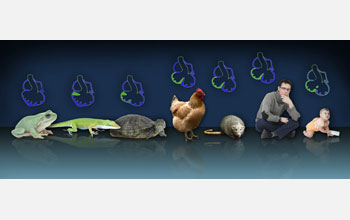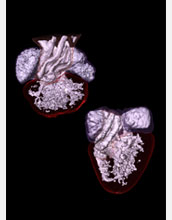All Images
News Release 09-164
Secrets of the Four Chambers Revealed by Reptile Hearts
The molecular blueprint for evolution from cold-blooded to warm-blooded has been found
This material is available primarily for archival purposes. Telephone numbers or other contact information may be out of date; please see current contact information at media contacts.

Embryo hearts show evolution of the heart from a three-chambered in frogs to a four-chambered in mammals.
Credit: Zina Deretsky, National Science Foundation after Benoit Brueau, the Gladstone Institute of Cardiovascular Disease
Download the high-resolution JPG version of the image. (931 KB)
Use your mouse to right-click (Mac users may need to Ctrl-click) the link above and choose the option that will save the file or target to your computer.
Benoit Bruneau of the Gladstone Institute of Cardiovascular Disease explains the discovery of the first genetic link in the evolution of the heart from three- to four-chambered. He walks through the anatomy of the cold-blooded frog heart that has three chambers; talks about its differences with the warm-blooded four-chambered heart, and explains some evolutionary advantages of being warm-blooded. He explains the molecular pattern of the protein Tbx5 and how it is different in embryo frog hearts compared with embryo mammal hearts. When the protein is present throughout the entire heart, three chambers form. However, when Tbx5 is restricted only to the left side of the heart, then the wall separating the two ventricles forms and four chambers result. When irregularities in the amounts of the protein occur in human babies, congenital heart defects of the septum result.
Credit: National Science Foundation/Gladstone Institute

The three-chambered frog heart mixes oxygenated and deoxygenated blood in the ventricle. Therefore, the body never receives fully oxygen-rich blood. In turtles, where a septum begins to form and separate the ventricles, the body receives slightly richer blood in oxygen. It is only in the warm-blooded model, in birds and mammals, that the two circulatory systems become fully separate sending low-pressure pumping to the lungs, and a high-pressure flow of blood to the rest of the body. In this model, the animal's muscles receive fully oxygenated blood.
Credit: Credit: Zina Deretsky, National Science Foundation
Download the high-resolution JPG version of the image. (481 KB)
Use your mouse to right-click (Mac users may need to Ctrl-click) the link above and choose the option that will save the file or target to your computer.

Embryo turtle heart on the left. Embryo lizard heart on the right.
Credit: Bogac Kaynak and Benoit Bruneau, Gladstone Institute of Cardiovascular Disease
Download the high-resolution JPG version of the image. (423 KB)
Use your mouse to right-click (Mac users may need to Ctrl-click) the link above and choose the option that will save the file or target to your computer.

Turtle embryo.
Credit: Sample obtained and photographed by Judy Cebra-Thomas and Scott Gilbert, Swarthmore College.
Download the high-resolution JPG version of the image. (124 KB)
Use your mouse to right-click (Mac users may need to Ctrl-click) the link above and choose the option that will save the file or target to your computer.
